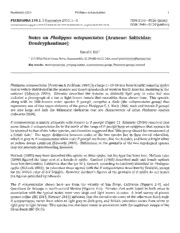
Notes on Phidippus octopunctatus (Araneae: Salticidae: Dendryphantinae) PDF
Preview Notes on Phidippus octopunctatus (Araneae: Salticidae: Dendryphantinae)
Peckhamia 130.1 Phidippus octopunctatus 1 PECKHAMIA 130.1, 3 September 2015, 1―5 ISSN 2161―8526 (print) ISSN 1944―8120 (online) urn:lsid:zoobank.org:pub:17A9F374-ABF6-4CDA-93D7-5DA83A290166 (registered 02 SEP 2015) Notes on Phidippus octopunctatus (Araneae: Salticidae: Dendryphantinae) David E. Hill 1 1 213 Wild Horse Creek Drive, Simpsonville, SC 29680-6513, USA, email [email protected] Key words: dendryphantine, jumping spider, octopunctatus group, Phidippus georgii, salticid Phidippus octopunctatus (Peckham & Peckham 1883) is a large (~10-18 mm body length) jumping spider that is widely distributed in the prairies and desert grasslands of western North America, maturing in the summer (Edwards 2004). Edwards described the females as distinctly light grey in color, but also included a photograph of a tan or light-brown female that resembles those shown here. This species, along with its little-known sister species P. georgii, comprise a clade (the octopunctatus group) that represents one of two major divisions of the genus Phidippus C. L. Koch 1846; male and female P. georgii are also large and lack the iridescent chelicerae that are characteristic of other Phidippus species (Edwards 2004). P. octopunctatus is mostly allopatric with respect to P. georgii (Figure 1). Edwards (2004) observed that some female P. octopunctatus far to the north of the range of P. georgii have an epigynum that appears to be identical to that of the latter species, and therefore suggested that "this group should be reexamined at a future date." The major distinction between males of the two species lies in their dorsal coloration, which is grey in P. octopunctatus while male P. georgii are brown, like the females, and have a bright white or yellow dorsal cymbium (Edwards 2004). Differences in the genitalia of the two typological species may not preclude interbreeding, however. McCook (1883) may have described this spider as Attus opifex, but his type has been lost. McCook later (1890) figured the large nest of a female A. opifex. Gardner (1965) described male and female spiders from San Bernardino, California, that she (or W. J. Gertsch, according to Gardner) identified as Phidippus opifex (McCook 1883). In coloration these agreed with the P. octopunctatus described by Edwards, except for the brown color of her females. However, Gardner's figures of the genitalia of P. opifex do not match the figures published by Edwards. The P. octopunctatus shown here are from the vicinity of San Diego, California (Figures 2-3), and Queretaro de Arteaga in north-central Mexico (Figures 4-5). Females that were found in both areas in association with the typical males were very large and light brown in color. A brief survey of photos posted online (BG 2015, Metzner 2015) indicates that the dorsal scale cover of the otherwise black male P. octopunctatus varies from white to light grey to dark grey, and female coloration varies from white to light grey to light brown. This species has also been found in association with the sagebrush steppe of the Great Basin (BG 2015). Peckhamia 130.1 Phidippus octopunctatus 2 4 4 41 1 1 411 11 1 1 1 1 1 1 1 4 1 111 1 114 1 3 1 41 1 1 1 1 1411 1 1 41114 1 11 1 1 1114411111411 41141 1 1 114 1 1 2 1 2 2 1 12 2 44 2 2 1 P. octopunctatus, Edwards 2004 2 2 1 2 P. georgii, Edwards 2004 3 P. octopunctatus, Richman et al. 2012 2 2 4 P. octopunctatus, FLICKR and BugGuide Figure 1. Localties associated with Phidippus octopunctatus and P. georgii in western North America, numbered to indicate source. Peckhamia 130.1 Phidippus octopunctatus 3 1 2 3 4 Figure 2. Female Phidippus octopunctatus from the vicinity of San Diego, California. Photographs by Mark A. Chappell, used with permission. 1 2 3 4 5 Figure 3. Male Phidippus octopunctatus from the vicinity of San Diego, California. Photographs by Mark A. Chappell, used with permission. Peckhamia 130.1 Phidippus octopunctatus 4 1 2 3 4 Figure 4. Male Phidippus octopunctatus from El Tejocote, Queretaro de Arteaga, Mexico (18 SEP 2010). Photographs by Carlos Mancilla, used with permission. 1 2 Figure 5. Phidippus octopunctatus from Queretaro de Arteaga, Mexico. 1, Male on exposed rock, La Loma (2 SEP 2009). 2, Female with large grasshopper on cactus, El Tejocote (20 SEP 2010). Photographs by Carlos Mancilla, used with permission. Peckhamia 130.1 Phidippus octopunctatus 5 Acknowledgments I thank Mark A. Chappell and Carlos Mancilla for allowing the use of their photographs. References BG. 2015. Species Phidippus octopunctatus. Online at: http://bugguide.net/node/view/105011/bgimage Edwards, G. B. 2004. Revision of the jumping spiders of the genus Phidippus (Araneae: Salticidae). Occasional Papers of the Florida State Collection of Arthropods. 11: i-vii, 1-156, end covers. Gardner, B. T. 1965. Observations on three species of Phidippus jumping spiders (Araneae: Salticdae). Psyche 72: 133-147. Koch, C. L. 1846. Die Arachniden. Nürnberg, Dreizehnter Band, pp. 1-234, Vierzehnter Band, pp. 1-88. Metzner, H. 2015. Jumping spiders (Arachnida: Araneae: Salticidae) of the world. Online at: http://www.jumping-spiders. com/ McCook, H. C. 1883 (1884). Note on two new Californian spiders and their nests. Proceedings of the Academy of Natural Sciences of Philadelphia 13: 229-232. McCook, H. C. 1890. American spiders and their spinning-work. Vol. 2. Philadelphia. 1-480. Peckham, G. W., and E. G. Peckham. 1883. Descriptions of new or little known spiders of the family Attidae, from various parts of the United States of North America. Milwaukee, Wisconsin. 1-35, plates I-III.
